2020 HYUNDAI GENESIS G90 brake
[x] Cancel search: brakePage 289 of 538
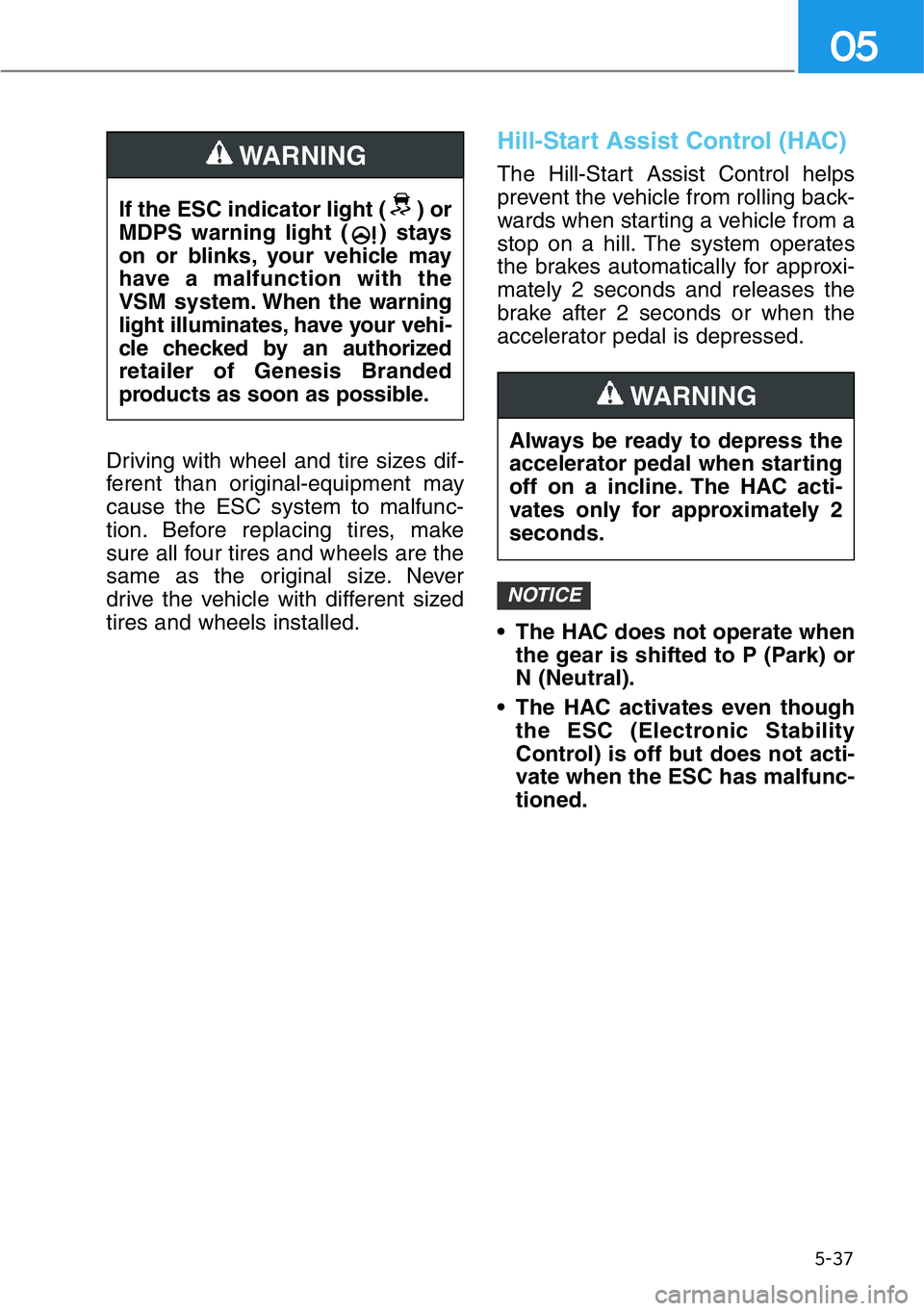
5-37
05
Driving with wheel and tire sizes dif-
ferent than original-equipment may
cause the ESC system to malfunc-
tion. Before replacing tires, make
sure all four tires and wheels are the
same as the original size. Never
drive the vehicle with different sized
tires and wheels installed.
Hill-Start Assist Control (HAC)
The Hill-Start Assist Control helps
prevent the vehicle from rolling back-
wards when starting a vehicle from a
stop on a hill. The system operates
the brakes automatically for approxi-
mately 2 seconds and releases the
brake after 2 seconds or when the
accelerator pedal is depressed.
• The HAC does not operate when
the gear is shifted to P (Park) or
N (Neutral).
• The HAC activates even though
the ESC (Electronic Stability
Control) is off but does not acti-
vate when the ESC has malfunc-
tioned.
NOTICE
If the ESC indicator light ( ) or
MDPS warning light ( ) stays
on or blinks, your vehicle may
have a malfunction with the
VSM system.When the warning
light illuminates, have your vehi-
cle checked by an authorized
retailer of Genesis Branded
products as soon as possible.
WARNING
Always be ready to depress the
accelerator pedal when starting
off on a incline. The HAC acti-
vates only for approximately 2
seconds.
WARNING
Page 290 of 538
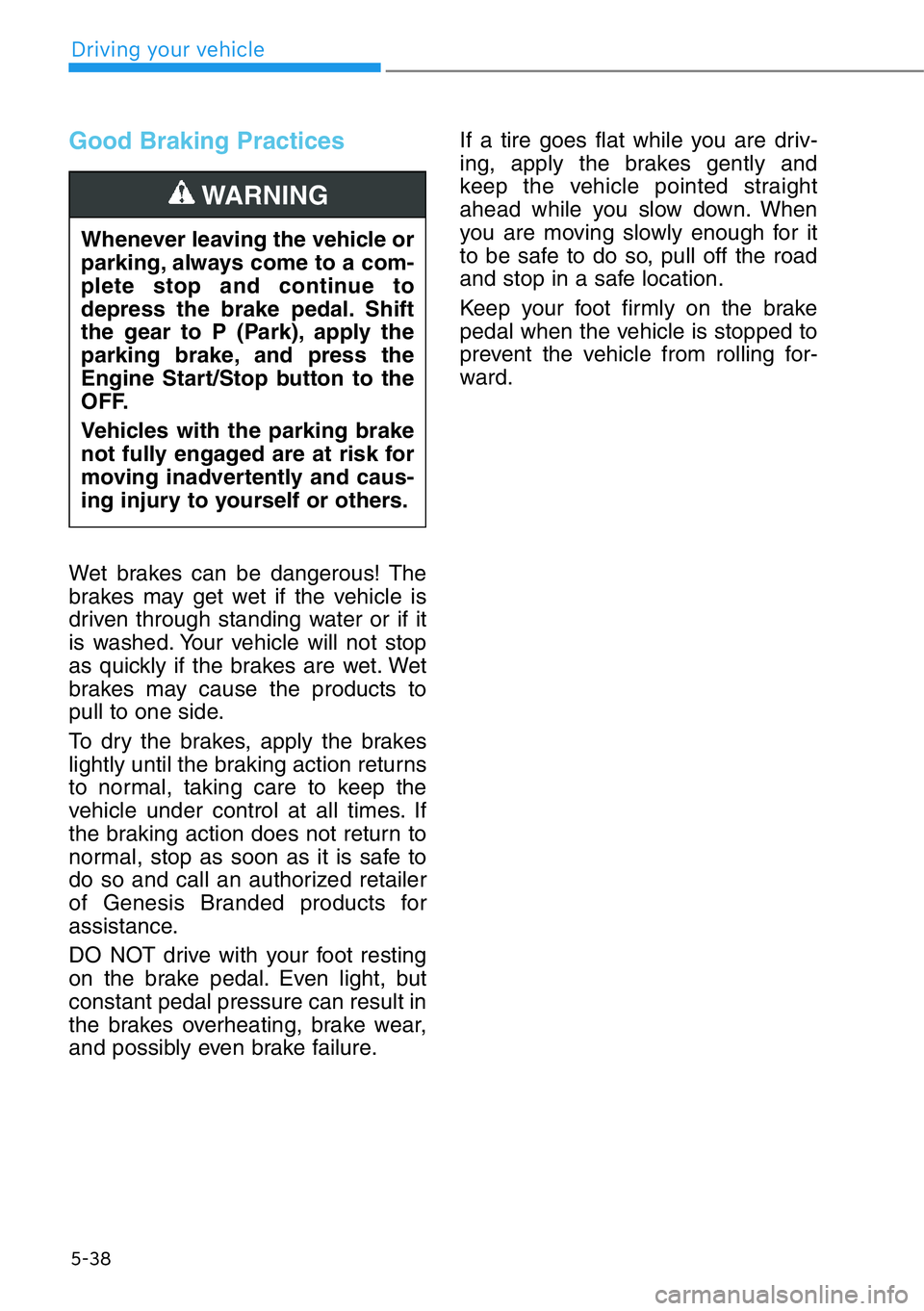
5-38
Driving your vehicle
Good Braking Practices
Wet brakes can be dangerous! The
brakes may get wet if the vehicle is
driven through standing water or if it
is washed. Your vehicle will not stop
as quickly if the brakes are wet. Wet
brakes may cause the products to
pull to one side.
To dry the brakes, apply the brakes
lightly until the braking action returns
to normal, taking care to keep the
vehicle under control at all times. If
the braking action does not return to
normal, stop as soon as it is safe to
do so and call an authorized retailer
of Genesis Branded products for
assistance.
DO NOT drive with your foot resting
on the brake pedal. Even light, but
constant pedal pressure can result in
the brakes overheating, brake wear,
and possibly even brake failure.If a tire goes flat while you are driv-
ing, apply the brakes gently and
keep the vehicle pointed straight
ahead while you slow down. When
you are moving slowly enough for it
to be safe to do so, pull off the road
and stop in a safe location.
Keep your foot firmly on the brake
pedal when the vehicle is stopped to
prevent the vehicle from rolling for-
ward. Whenever leaving the vehicle or
parking, always come to a com-
plete stop and continue to
depress the brake pedal. Shift
the gear to P (Park), apply the
parking brake, and press the
Engine Start/Stop button to the
OFF.
Vehicles with the parking brake
not fully engaged are at risk for
moving inadvertently and caus-
ing injury to yourself or others.
WARNING
Page 292 of 538
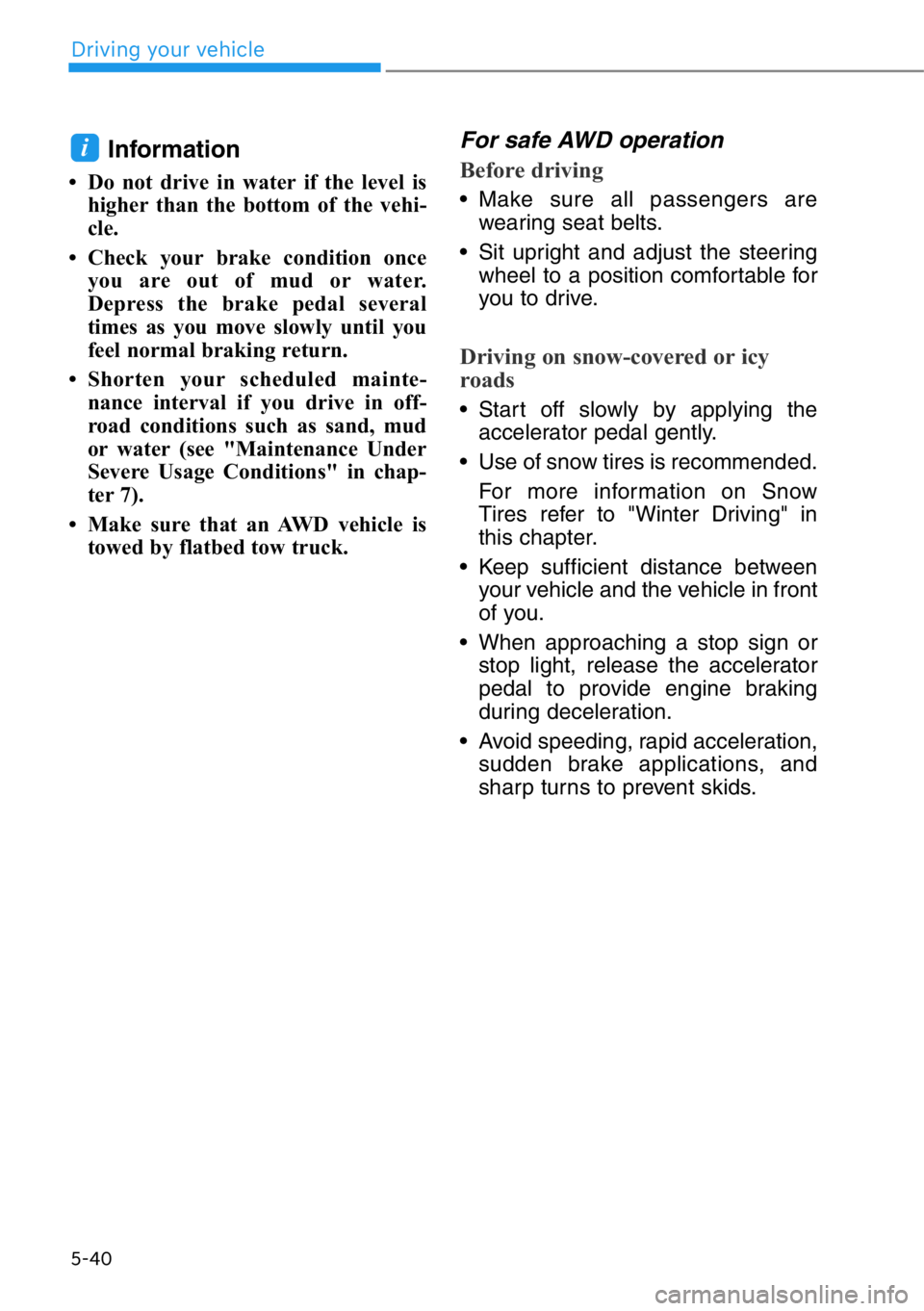
Information
• Do not drive in water if the level is
higher than the bottom of the vehi-
cle.
• Check your brake condition once
you are out of mud or water.
Depress the brake pedal several
times as you move slowly until you
feel normal braking return.
• Shorten your scheduled mainte-
nance interval if you drive in off-
road conditions such as sand, mud
or water (see "Maintenance Under
Severe Usage Conditions" in chap-
ter 7).
• Make sure that an AWD vehicle is
towed by flatbed tow truck.
For safe AWD operation
Before driving
• Make sure all passengers are
wearing seat belts.
• Sit upright and adjust the steering
wheel to a position comfortable for
you to drive.
Driving on snow-covered or icy
roads
• Start off slowly by applying the
accelerator pedal gently.
• Use of snow tires is recommended.
For more information on Snow
Tires refer to "Winter Driving" in
this chapter.
• Keep sufficient distance between
your vehicle and the vehicle in front
of you.
• When approaching a stop sign or
stop light, release the accelerator
pedal to provide engine braking
during deceleration.
• Avoid speeding, rapid acceleration,
sudden brake applications, and
sharp turns to prevent skids.
i
5-40
Driving your vehicle
Page 293 of 538

Driving in sand or mud
• Maintain slow and constant speed.
• Keep sufficient distance between
your vehicle and the vehicle in front
of you.
• Reduce vehicle speed and always
check the road condition.
• Avoid speeding, rapid acceleration,
sudden brake applications, and
sharp turns to prevent getting
stuck.
When the vehicle is stuck in snow,
sand or mud, avoid running the
engine continuously at high rpm,
doing so may damage the tires,
transmission, differential or AWD
system.
Information
• When using Snow Tires, mount
them on all four wheels.
• When using AutoSock
®(fabric snow
chain), install them on the rear tires.
For more information on Snow Tires
and Tire Chains, refer to "Winter
Driving" in this chapter.
Driving up or down hills
• Driving uphill
- Before starting off, check if it is
possible to drive uphill.
- Drive as straight as possible.
• Driving downhill
- Do not change gear while driving
downhill. Select gear before driv-
ing downhill.
- Drive slowly and select Manual
Shift Mode to provide engine
braking while driving downhill.
- Drive straight as possible.
i
NOTICE
5-41
05
Exercise extreme caution driv-
ing up or down steep hills. The
vehicle may flip depending on
the grade, terrain and water/
mud conditions.
WARNING
Page 295 of 538
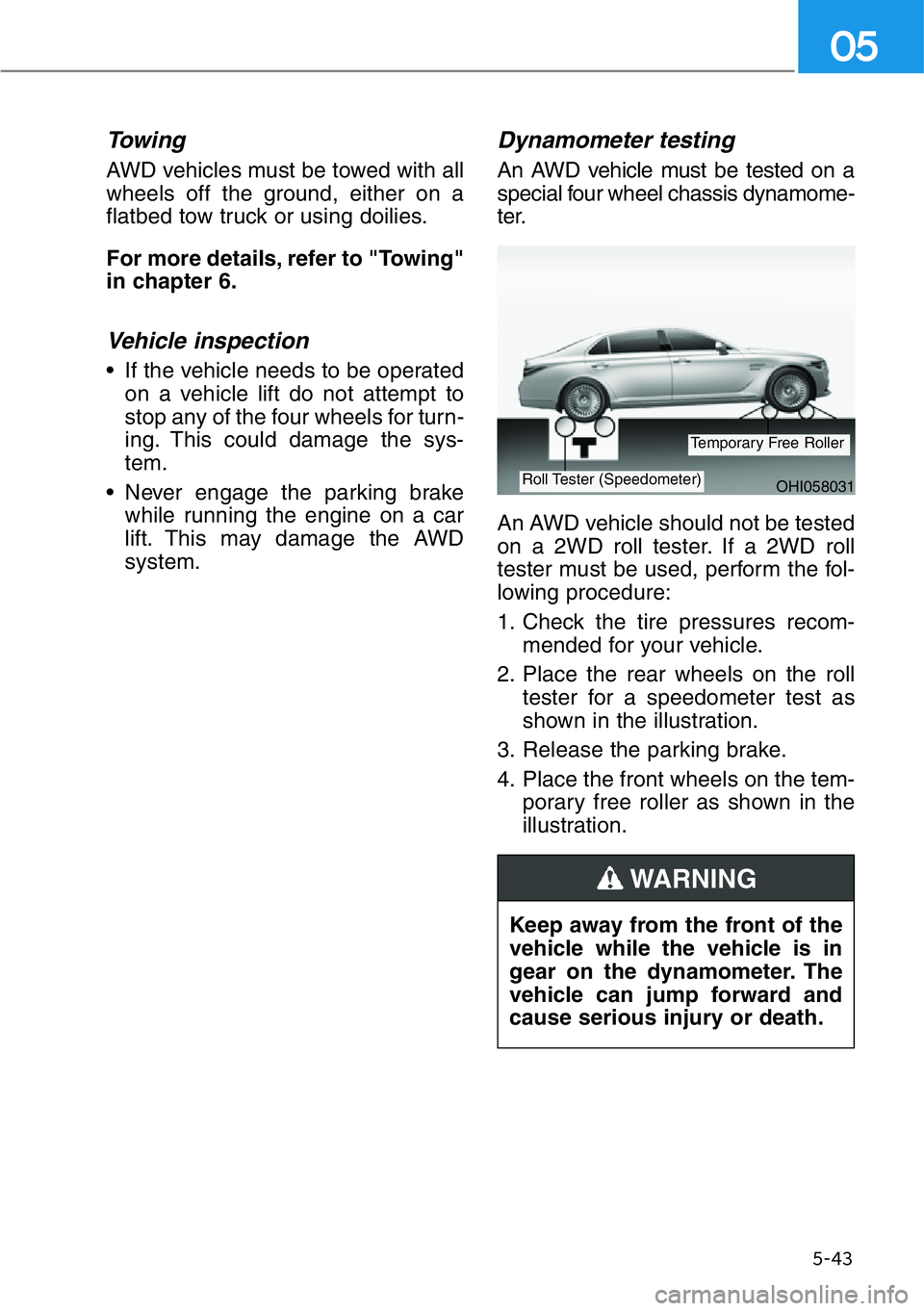
Towing
AWD vehicles must be towed with all
wheels off the ground, either on a
flatbed tow truck or using doilies.
For more details, refer to "Towing"
in chapter 6.
Vehicle inspection
• If the vehicle needs to be operated
on a vehicle lift do not attempt to
stop any of the four wheels for turn-
ing. This could damage the sys-
tem.
• Never engage the parking brake
while running the engine on a car
lift. This may damage the AWD
system.
Dynamometer testing
An AWD vehicle must be tested on a
special four wheel chassis dynamome-
ter.
An AWD vehicle should not be tested
on a 2WD roll tester. If a 2WD roll
tester must be used, perform the fol-
lowing procedure:
1. Check the tire pressures recom-
mended for your vehicle.
2. Place the rear wheels on the roll
tester for a speedometer test as
shown in the illustration.
3. Release the parking brake.
4. Place the front wheels on the tem-
porary free roller as shown in the
illustration.
5-43
05
OHI058031Roll Tester (Speedometer)
Temporary Free Roller
Keep away from the front of the
vehicle while the vehicle is in
gear on the dynamometer. The
vehicle can jump forward and
cause serious injury or death.
WARNING
Page 299 of 538
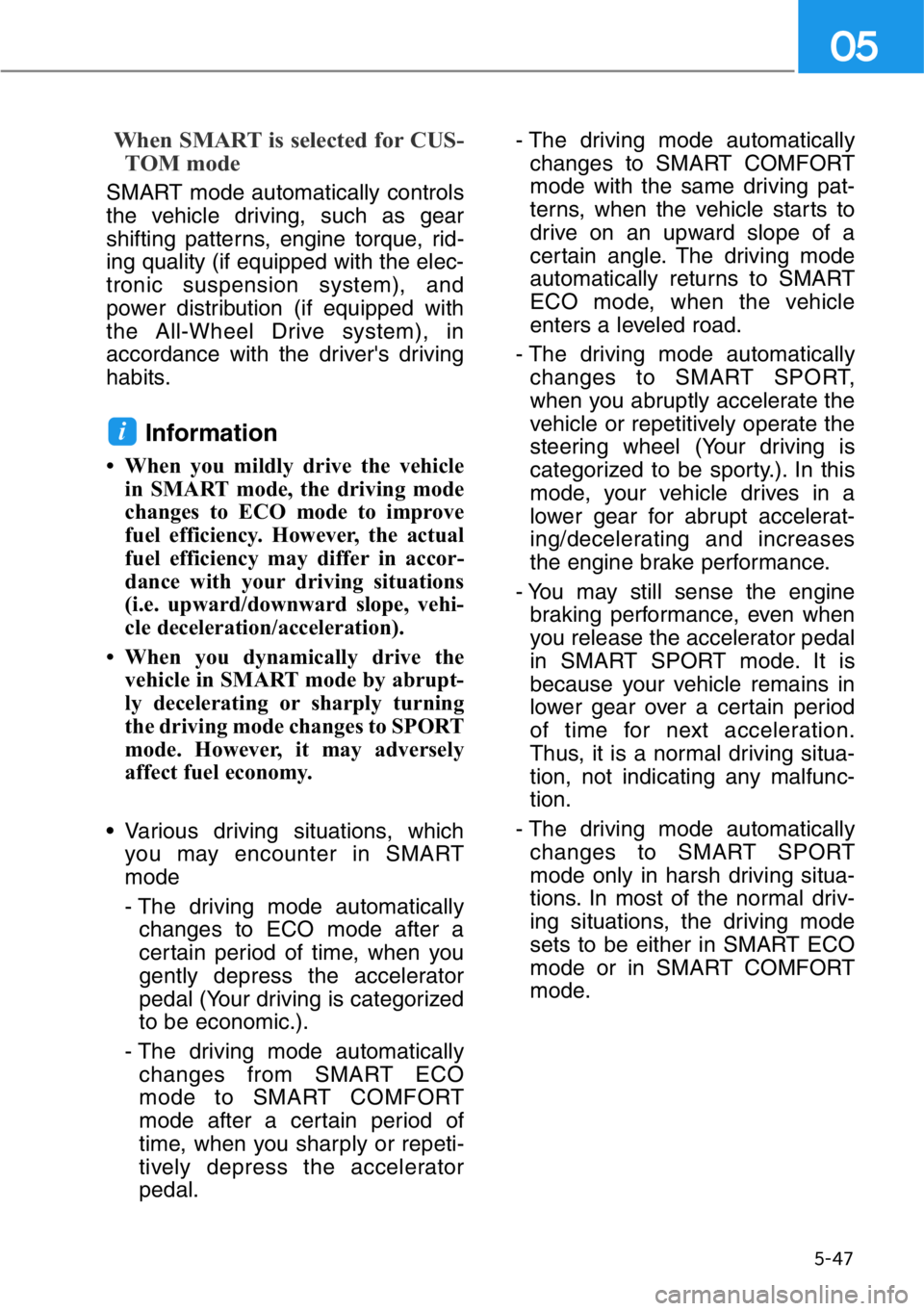
5-47
05
When SMART is selected for CUS-
TOM mode
SMART mode automatically controls
the vehicle driving, such as gear
shifting patterns, engine torque, rid-
ing quality (if equipped with the elec-
tronic suspension system), and
power distribution (if equipped with
the All-Wheel Drive system), in
accordance with the driver's driving
habits.
Information
• When you mildly drive the vehicle
in SMART mode, the driving mode
changes to ECO mode to improve
fuel efficiency. However, the actual
fuel efficiency may differ in accor-
dance with your driving situations
(i.e. upward/downward slope, vehi-
cle deceleration/acceleration).
• When you dynamically drive the
vehicle in SMART mode by abrupt-
ly decelerating or sharply turning
the driving mode changes to SPORT
mode. However, it may adversely
affect fuel economy.
• Various driving situations, which
you may encounter in SMART
mode
- The driving mode automatically
changes to ECO mode after a
certain period of time, when you
gently depress the accelerator
pedal (Your driving is categorized
to be economic.).
- The driving mode automatically
changes from SMART ECO
mode to SMART COMFORT
mode after a certain period of
time, when you sharply or repeti-
tively depress the accelerator
pedal.- The driving mode automatically
changes to SMART COMFORT
mode with the same driving pat-
terns, when the vehicle starts to
drive on an upward slope of a
certain angle. The driving mode
automatically returns to SMART
ECO mode, when the vehicle
enters a leveled road.
- The driving mode automatically
changes to SMART SPORT,
when you abruptly accelerate the
vehicle or repetitively operate the
steering wheel (Your driving is
categorized to be sporty.). In this
mode, your vehicle drives in a
lower gear for abrupt accelerat-
ing/decelerating and increases
the engine brake performance.
- You may still sense the engine
braking performance, even when
you release the accelerator pedal
in SMART SPORT mode. It is
because your vehicle remains in
lower gear over a certain period
of time for next acceleration.
Thus, it is a normal driving situa-
tion, not indicating any malfunc-
tion.
- The driving mode automatically
changes to SMART SPORT
mode only in harsh driving situa-
tions. In most of the normal driv-
ing situations, the driving mode
sets to be either in SMART ECO
mode or in SMART COMFORT
mode.
i
Page 301 of 538
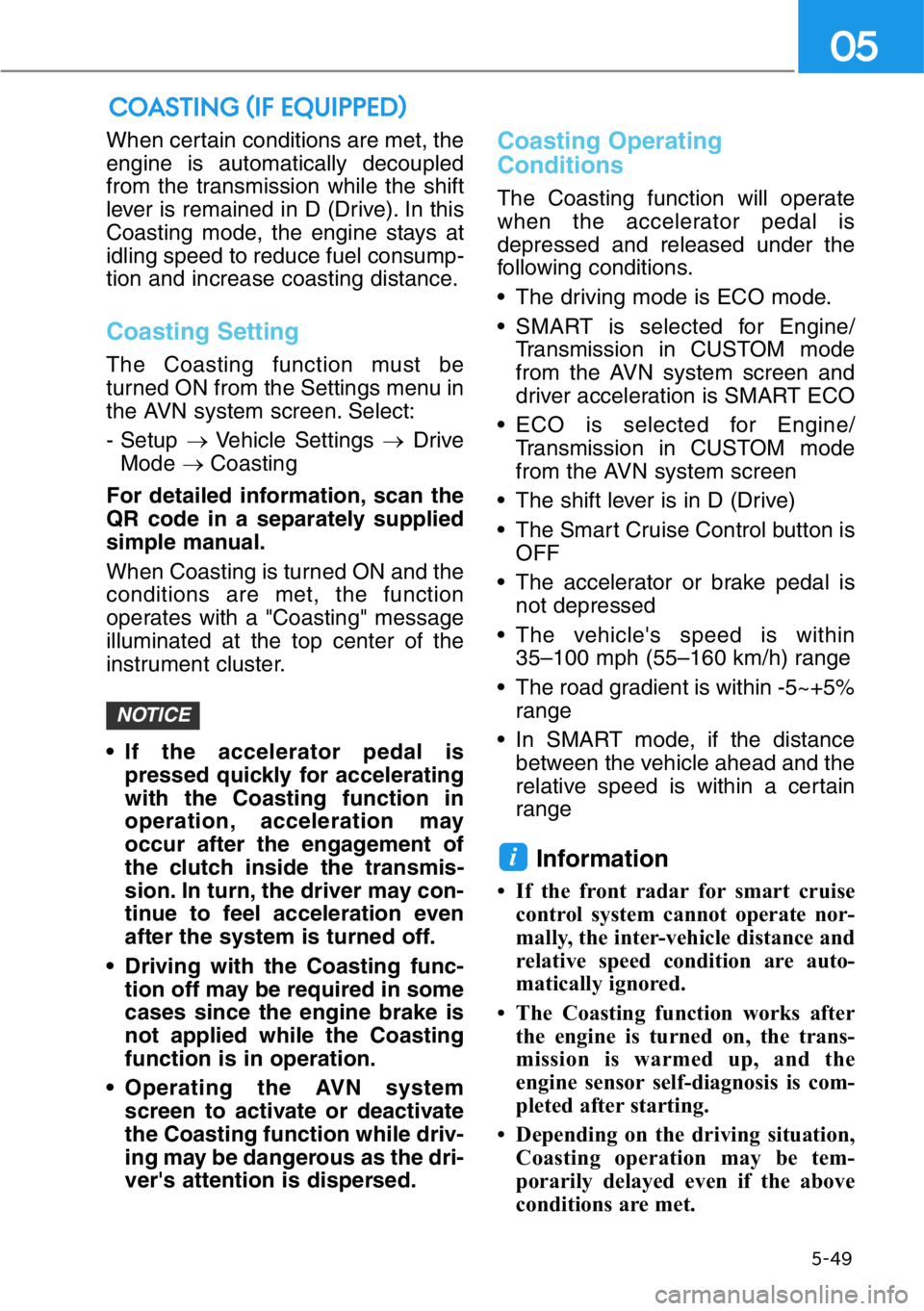
When certain conditions are met, the
engine is automatically decoupled
from the transmission while the shift
lever is remained in D (Drive). In this
Coasting mode, the engine stays at
idling speed to reduce fuel consump-
tion and increase coasting distance.
Coasting Setting
The Coasting function must be
turned ON from the Settings menu in
the AVN system screen. Select:
- Setup →Vehicle Settings →Drive
Mode →Coasting
For detailed information, scan the
QR code in a separately supplied
simple manual.
When Coasting is turned ON and the
conditions are met, the function
operates with a "Coasting" message
illuminated at the top center of the
instrument cluster.
• If the accelerator pedal is
pressed quickly for accelerating
with the Coasting function in
operation, acceleration may
occur after the engagement of
the clutch inside the transmis-
sion. In turn, the driver may con-
tinue to feel acceleration even
after the system is turned off.
• Driving with the Coasting func-
tion off may be required in some
cases since the engine brake is
not applied while the Coasting
function is in operation.
• Operating the AVN system
screen to activate or deactivate
the Coasting function while driv-
ing may be dangerous as the dri-
ver's attention is dispersed.
Coasting Operating
Conditions
The Coasting function will operate
when the accelerator pedal is
depressed and released under the
following conditions.
• The driving mode is ECO mode.
• SMART is selected for Engine/
Transmission in CUSTOM mode
from the AVN system screen and
driver acceleration is SMART ECO
• ECO is selected for Engine/
Transmission in CUSTOM mode
from the AVN system screen
• The shift lever is in D (Drive)
• The Smart Cruise Control button is
OFF
• The accelerator or brake pedal is
not depressed
• The vehicle's speed is within
35–100 mph (55–160 km/h) range
• The road gradient is within -5~+5%
range
• In SMART mode, if the distance
between the vehicle ahead and the
relative speed is within a certain
range
Information
• If the front radar for smart cruise
control system cannot operate nor-
mally, the inter-vehicle distance and
relative speed condition are auto-
matically ignored.
• The Coasting function works after
the engine is turned on, the trans-
mission is warmed up, and the
engine sensor self-diagnosis is com-
pleted after starting.
• Depending on the driving situation,
Coasting operation may be tem-
porarily delayed even if the above
conditions are met.
i
NOTICE
COASTING (IF EQUIPPED)
5-49
05
Page 305 of 538
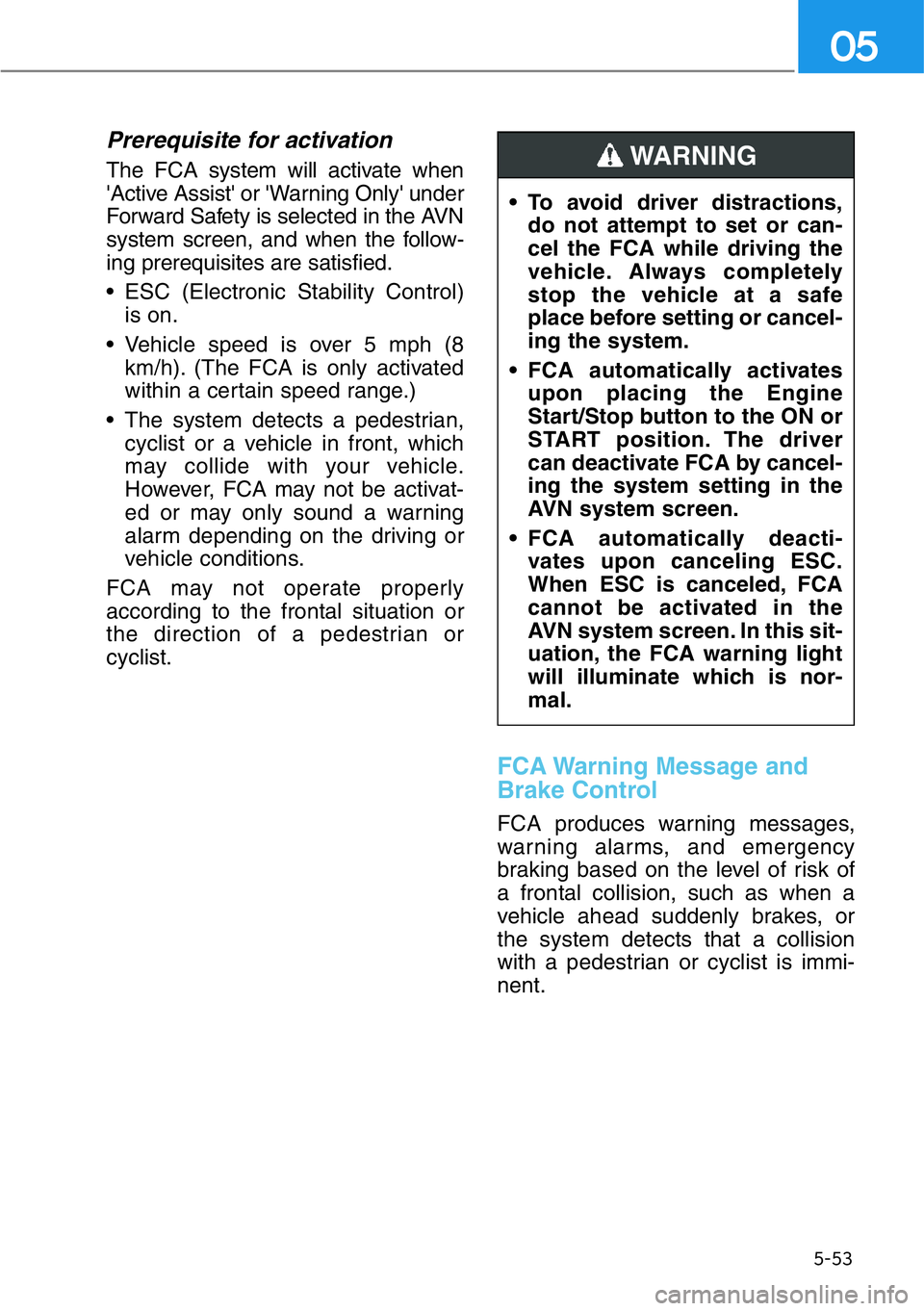
Prerequisite for activation
The FCA system will activate when
'Active Assist' or 'Warning Only' under
Forward Safety is selected in the AVN
system screen, and when the follow-
ing prerequisites are satisfied.
• ESC (Electronic Stability Control)
is on.
• Vehicle speed is over 5 mph (8
km/h). (The FCA is only activated
within a certain speed range.)
• The system detects a pedestrian,
cyclist or a vehicle in front, which
may collide with your vehicle.
However, FCA may not be activat-
ed or may only sound a warning
alarm depending on the driving or
vehicle conditions.
FCA may not operate properly
according to the frontal situation or
the direction of a pedestrian or
cyclist.
FCA Warning Message and
Brake Control
FCA produces warning messages,
warning alarms, and emergency
braking based on the level of risk of
a frontal collision, such as when a
vehicle ahead suddenly brakes, or
the system detects that a collision
with a pedestrian or cyclist is immi-
nent.
5-53
05
• To avoid driver distractions,
do not attempt to set or can-
cel the FCA while driving the
vehicle. Always completely
stop the vehicle at a safe
place before setting or cancel-
ing the system.
• FCA automatically activates
upon placing the Engine
Start/Stop button to the ON or
START position. The driver
can deactivate FCA by cancel-
ing the system setting in the
AVN system screen.
• FCA automatically deacti-
vates upon canceling ESC.
When ESC is canceled, FCA
cannot be activated in the
AVN system screen. In this sit-
uation, the FCA warning light
will illuminate which is nor-
mal.
WARNING